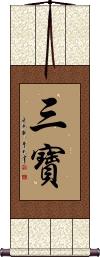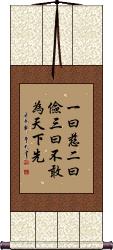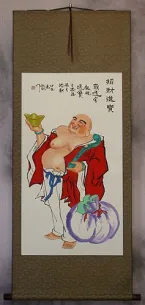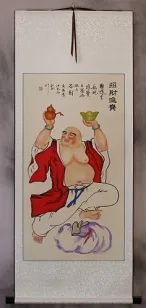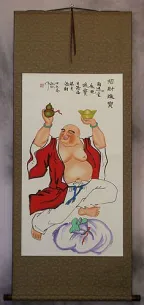Many custom options...
And formats...

Three Treasures in Chinese / Japanese...
Buy a Three Treasures calligraphy wall scroll here!
Personalize your custom “Three Treasures” project by clicking the button next to your favorite “Three Treasures” title below...
1. Three Treasures of Buddhism
2. Take Refuge in the Three Treasures
3. Three Treasures of Chinese Medicine
Three Treasures of Buddhism
The Triple Gem
三寶 is the title for “Three Precious Treasures of Buddhism” or “The Triple Gem.”
These three treasures are the Buddha 佛, the Dharma 法 (teachings or the law of the Buddha), and the Sangha 僧 (the community of monks or followers).
This term is used by most (perhaps not all) Buddhists in China, Japan, and South Korea (written the same in the original form but pronounced differently in each language). Non-Buddhists may just read this as “Three Treasures” without the religious context. For instance, there is also a “Three Treasures of Chinese Medicine” that is sometimes titled the same way.
In modern Japanese and Simplified Chinese, this is written 三宝 instead of 三寶.
Take Refuge in the Three Treasures
Take Refuge in the Three Treasures
Three Treasures of Chinese Medicine
精, 氣, 神 are the characters jing, qi, and shen.
As a set, these three characters are known in English as the treasures of traditional Chinese medicine, the treasures of Qi Gong, or the three treasures of Taoism / Daoism.
Sometimes this set is titled 三寶 (sānbǎo) or “three treasures,” but here, we're writing each treasure out.
Here's how these characters are perceived in this context...
Jing: nutritive essence; refined; perfected; pure
Qi: vitality; energy; force; breath; vigor
Shen: spirit; soul; mind; being
To keep it simple, you can use “essence, vitality, and spirit” to define these.
Daodejing / Tao Te Ching - Excerpt
Excerpt from Chapter 67
一曰慈二曰儉三曰不敢為天下先 is an excerpt from the 67th Chapter of Lao Tzu's (Lao Zi's) Te-Tao Ching (Dao De Jing).
This is the part where the three treasures are discussed. In English, we'd say these three treasures are compassion, frugality, and humility. Some may translate these as love, moderation, and lack of arrogance. I have also seen them translated as benevolence, modesty, and “Not presuming to be at the forefront in the world.” You can mix them up the way you want, as translation is not really a science but rather an art.
I should also explain that the first two treasures are single-character ideas, yet the third treasure was written out in six characters (there are also some auxiliary characters to number the treasures).
If Lao Tzu's words are important to you, then a wall scroll with this passage might make a great addition to your home.
Precious / Treasure
貴重品 means precious or treasured as an adjective or as a noun, valuables or treasures in Japanese.
貴重品 exists in the Korean dictionary but is rarely if ever, used in Korea.
Love Gems / Fruit of Love / Children
This in-stock artwork might be what you are looking for, and ships right away...
Gallery Price: $200.00
Your Price: $69.88
Gallery Price: $200.00
Your Price: $69.88
Not the results for three treasures that you were looking for?
Below are some entries from our dictionary that may match your three treasures search...
| Characters If shown, 2nd row is Simp. Chinese |
Pronunciation Romanization |
Simple Dictionary Definition |
馬 马 see styles |
mǎ ma3 ma me め |
More info & calligraphy: Horse(1) horse; (2) (See 競馬) horse racing; (3) (abbreviation) {shogi} (See 竜馬・2) promoted bishop; (4) {cards} knight (court card in mekuri karuta and unsun karuta); (surname) Me aśva, a horse; a stallion; one of the seven treasures of a sovereign. |
三宝 see styles |
sanpou / sanpo さんぽう |
More info & calligraphy: Three Treasures of Buddhism |
三寶 三宝 see styles |
sān bǎo san1 bao3 san pao sanbou / sanbo さんぼう |
More info & calligraphy: Three Treasures of Buddhism(surname) Sanbou three treasures |
南無三寶 南无三宝 see styles |
nán wú sān bǎo nan2 wu2 san1 bao3 nan wu san pao namu sanbō |
More info & calligraphy: Take Refuge in the Three Treasures |
歸依三寶 归依三宝 see styles |
guī yī sān bǎo gui1 yi1 san1 bao3 kuei i san pao kie sanbō |
More info & calligraphy: Take Refuge in the Three Treasures |
七宝 see styles |
nanahou / nanaho ななほう |
(1) {Buddh} the seven treasures (gold, silver, pearls, agate, crystal, coral, lapis lazuli); (2) (abbreviation) (See 七宝焼き) cloisonne ware; (3) (しっぽう only) (abbreviation) (See 七宝つなぎ) shippō pattern (of overlapping circles); (4) (しっぽう only) shippō emblem; (surname) Nanahou |
七寶 七宝 see styles |
qī bǎo qi1 bao3 ch`i pao chi pao shichihō |
sapta ratna 薩不荅羅的捺 The seven treasures, or precious things, of which there are varying descriptions, e.g. 金 suvarna, gold; 銀rūpya, silver; 鐂璃 vaiḍūrya, lapis lazuli; 玻瓈sphaṭika, crystal; 硨磲 musāragalva, agate; 赤珠 rohita-mukta, rubies or red pearls; 瑪瑙 aśmagarbha, cornelian. Also the seven royal (cakravartin) treasures―the golden wheel; elephants; dark swift horses; the divine pearl, or beautiful pearls; able ministers of the Treasury; jewels of women; and loyal generals. |
七珍 see styles |
qī zhēn qi1 zhen1 ch`i chen chi chen shicchin; shichichin しっちん; しちちん |
(1) {Buddh} (See 七宝・1) the seven treasures (gold, silver, pearls, agate, crystal, coral, lapis lazuli); (2) the seven delicacies idem 七寶. |
万宝 see styles |
manpou / manpo まんぽう |
many treasures; (surname) Manpou |
三寳 三宝 see styles |
sān bǎo san1 bao3 san pao sanbō |
Triratna, or Ratnatraya, i.e. the Three Precious Ones: 佛 Buddha, 法 Dharma, 儈 Saṅgha, i.e. Buddha, the Law, the Ecelesia or Order. Eitel suggests this trinity may be adapted from the Trimūrti, i.e, Brahma, Viṣṇu, and Sīva. The Triratna takes many forms, e.g. the Trikāya 三身 q.v. There is also the Nepalese idea of a triple existence of each Buddha as a Nirvāṇa-Buddha, Dhyāni-Buddha, and Mānuṣi-Buddha; also the Tantric trinity of Vairocana as Nirvāṇa-Buddha, Locana according to Eitel "existing in reflex in the world of forms", and the human Buddha, Śākyamuni. There are other elaborated details known as the four and the six kinds of triratna 四 and 六種三寳, e.g. that the Triratna exists in each member of the trinity. The term has also been applied to the 三仙 q.v. Popularly the 三寳 are referred to the three images in the main hall of monasteries. The centre one is Śākyamuni, on his left Bhaiṣajya 藥師 and on his right Amitābha. There are other explanations, e.g. in some temples Amitābha is in the centre, Avalokiteśvara on his left, and Mahāsthāmaprāpta or Mañjuśrī on his right. Table of Triratna, Trikāya, and Trailokya: — DHARMASAṄGHABUDDHAEssential BodhiReflected BodhiPractical BodhiDhyāni BuddhaDhyāni BodhisattvaMānuṣī BuddhaDharmakāyaSambhogakāyaNirmāṇakāyaPurityCompletenessTransformations4th Buddha-kṣetra3rd Buddha-kṣetra1st and 2nd Buddha kṣetraArūpadhātuRūpadhātuKāmadhātu. |
五寶 五宝 see styles |
wǔ bǎo wu3 bao3 wu pao gohou / goho ごほう |
(personal name) Gohou The five precious things, syn. all the precious things. There are several groups, e. g. — gold, silver, pearls, cowries, and rubies; or, coral, crystal, gold, silver, and cowries; or, gold, silver, pearls, coral, and amber; etc. |
他寶 他宝 see styles |
tā bǎo ta1 bao3 t`a pao ta pao tahō |
another's treasures |
多寶 多宝 see styles |
duō bǎo duo1 bao3 to pao Tahō |
(多寳) (多寳如來, 多寶如來) Prabhūtaratna, abundant treasures, or many jewels. The Ancient Buddha, long in nirvana, who appears in his stūpa to hear the Buddha preach the Lotus doctrine, by his presence revealing, inter alia, that nirvana is not annihilation, and that the Lotus doctrine is the Buddha-gospel; v. Lotus Sutra 寳塔品. |
寶女 宝女 see styles |
bǎo nǚ bao3 nv3 pao nü hōnyo |
kanyā-ratna; precious maidens, one of the seven treasures of the cakravartin; also 玉女. |
寶玉 宝玉 see styles |
bǎo yù bao3 yu4 pao yü |
precious jade; treasures See: 宝玉 |
寶王 宝王 see styles |
bǎo wáng bao3 wang2 pao wang hōō |
The Precious King, or King of Treasures, a title of Buddha; the ruler of the continent west of Sumeru, also called 寶主 Jewel-lord, or Lord of jewels. |
寶積 宝积 see styles |
bǎo jī bao3 ji1 pao chi houseki / hoseki ほうせき |
(surname) Houseki ratna-rāśi, or ratna-kūṭa. Gem-heap; collection of gems; accumulated treasures. |
寶藏 宝藏 see styles |
bǎo zàng bao3 zang4 pao tsang hōzō |
precious mineral deposits; hidden treasure; (fig.) treasure; (Buddhism) the treasure of Buddha's law The treasury of precious things, the wonderful religion of Buddha. |
御物 see styles |
gyobutsu ぎょぶつ |
Imperial treasures; (personal name) Gyobutsu |
摩尼 see styles |
mó ní mo2 ni2 mo ni mani まに |
Mani (3rd century AD), Persian prophet and founder of Manichaeism (1) {Buddh} jewel (san: mani); pearl; gemstone; (2) {Buddh} Cintamani stone; wish-fulfilling jewel; (surname) Mani maṇi; 'a jewel, gem, precious stone (especially a pearl, bead, or other globular ornament).' M.W. A bright luminous pearl, symbol of Buddha and his doctrines. Tr. 'as wished', or at wish, whoever possesses the pearl receives whatever he desires. One of the seven treasures. With Shivaites a symbol of the Liṅga. Also 末尼. |
文殊 see styles |
wén shū wen2 shu1 wen shu monju もんじゅ |
Manjushri, the Bodhisattva of keen awareness (Buddhist term) Manjushri; Manjusri; Bodhisattva that represents transcendent wisdom; (p,s,f) Monju (文殊師利) Mañjuśrī 滿殊尸利 -later 曼殊室利. 文殊 is also used for Mañjunātha, Mañjudeva, Mañjughoṣa, Mañjuṣvara, et al. T., hjamdpal; J., Monju. Origin unknown; presumably, like most Buddhas and bodhisattvas, an idealization of a particular quality, in his case of Wisdom. Mañju is beautiful, Śrī; good fortune, virtue, majesty, lord, an epithet of a god. Six definitions are obtained from various scriptures: 妙首 (or 頭 ) wonderful or beautiful) head; 普首 universal head; 濡首 glossy head (probably a transliteration); 敬首 revered head; 妙德 wonderful virtue (or power); 妙吉祥 wonderfully auspicious; the last is a later translation in the 西域記. As guardian of wisdom 智慧 he is often placed on Śākyamuni's left, with 普顯 on the right as guardian of law 理, the latter holding the Law, the former the wisdom or exposition of it; formerly they held the reverse positions. He is often represented with five curls or waves to his hair indicating the 五智 q. v. or the five peaks; his hand holds the sword of wisdom and he sits on a lion emblematic of its stern majesty: but he has other forms. He is represented as a youth, i. e. eternal youth. His present abode is given as east of the universe, known as 淸涼山 clear and cool mountain, or a region 寶住 precious abode, or Abode of Treasures, or 寶氏 from which he derives one of his titles, 寶相如來. One of his dhāraṇīs prophesies China as his post-nirvāṇa realm. In past incarnations he is described as being the parent of many Buddhas and as having assisted the Buddha into existence; his title was 龍種上佛 the supreme Buddha of the nāgas, also 大身佛 or 神仙佛; now his title is 歡喜藏摩尼寶精佛 The spiritual Buddha who joyfully cares for the jewel: and his future title is to be 普現佛 Buddha universally revealed. In the 序品 Introductory Chapter of the Lotus Sutra he is also described as the ninth predecessor or Buddha-ancestor of Śākyamuni. He is looked on as the chief of the Bodhisattvas and represents them, as the chief disciple of the Buddha, or as his son 法王子. Hīnayāna counts Śāriputra as the wisest of the disciples, Mahāyāna gives Mañjuśrī the chief place, hence he is also styled 覺母 mother, or begetter of understanding. He is shown riding on either a lion or a peacock, or sitting on a white lotus; often he holds a book, emblem of wisdom, or a blue lotus; in certain rooms of a monastery he is shown as a monk; and he appears in military array as defender of the faith. His signs, magic words, and so on, are found in various sutras. His most famous centre in China is Wu-tai shan in Shansi. where he is the object of pilgrimages, especially of Mongols. The legends about him are many. He takes the place in Buddhism of Viśvakarman as Vulcan, or architect, of the universe. He is one of the eight Dhyāni-bodhisattvas, and sometimes has the image of Akṣobhya in his crown. He was mentioned in China as early as the fourth century and in the Lotus Sutra he frequently appears, especially as the converter of the daughter of the Dragon-king of the Ocean. He has five messengers 五使者 and eight youths 八童子 attending on him. His hall in the Garbhadhātu maṇḍala is the seventh, in which his group numbers twenty-five. His position is northeast. There are numerous sutras and other works with his name as title, e. g. 文殊師利問菩提經 Gayaśīrṣa sūtra, tr. by Kumārajīva 384-417: and its 論 or .Tīkā of Vasubandhu, tr. by Bodhiruci 535. see list in B. N. |
獻寶 献宝 see styles |
xiàn bǎo xian4 bao3 hsien pao |
to present a treasure; to offer a valuable piece of advice; to show off what one treasures |
珊明 see styles |
shān míng shan1 ming2 shan ming sanmyō |
pravāḍa, or prabāla, coral, one of the seven treasures. |
神剣 see styles |
shinken しんけん |
divine sword (one of the three sacred treasures) |
神器 see styles |
shén qì shen2 qi4 shen ch`i shen chi jingi; shinki; shingi(ok) じんぎ; しんき; しんぎ(ok) |
magical object; object symbolic of imperial power; fine weapon; very useful tool (1) (See 三種の神器・1) sacred treasure; the three sacred treasures (sword, jewel, mirror); (2) implement used in religious ceremonies |
神鏡 see styles |
shinkyou / shinkyo しんきょう |
divine mirror; sacred mirror (one of the three sacred treasures) |
遺宝 see styles |
ihou / iho いほう |
historical treasures |
雜寶 杂宝 see styles |
zá bǎo za2 bao3 tsa pao zappō |
sundry treasures |
齋筵 斋筵 see styles |
zhāi yán zhai1 yan2 chai yen |
Offerings of food to the triratna. |
七聖財 七圣财 see styles |
qī shèng cái qi1 sheng4 cai2 ch`i sheng ts`ai chi sheng tsai shichi shōzai |
seven holy treasures |
Click here for more three treasures results from our dictionary
The following table may be helpful for those studying Chinese or Japanese...
| Title | Characters | Romaji (Romanized Japanese) | Various forms of Romanized Chinese | |
| Three Treasures of Buddhism | 三寶 三宝 | san bou / sanbou / san bo | sān bǎo / san1 bao3 / san bao / sanbao | san pao / sanpao |
| Take Refuge in the Three Treasures | 南無三寶 南无三宝 | na mu san bou namusanbou na mu san bo | nán mo sān bǎo nan2 mo san1 bao3 nan mo san bao nanmosanbao | nan mo san pao nanmosanpao |
| Take Refuge in the Three Treasures | 歸依三寶 归依三宝 | ki e san bou kiesanbou ki e san bo | guī yī sān bǎo gui1 yi1 san1 bao3 gui yi san bao guiyisanbao | kuei i san pao kueiisanpao |
| Three Treasures of Chinese Medicine | 精氣神 精气神 | jīng qì shén jing1 qi4 shen2 jing qi shen jingqishen | ching ch`i shen chingchishen ching chi shen |
|
| Daodejing Tao Te Ching - Excerpt | 一曰慈二曰儉三曰不敢為天下先 一曰慈二曰俭三曰不敢为天下先 | yī yuē cí èr yuē jiǎn sān yuē bù gǎn wéi tiān xià xiān yi1 yue1 ci2 er4 yue1 jian3 san1 yue1 bu4 gan3 wei2 tian1 xia4 xian1 yi yue ci er yue jian san yue bu gan wei tian xia xian | i yüeh tz`u erh yüeh chien san yüeh pu kan wei t`ien hsia hsien i yüeh tzu erh yüeh chien san yüeh pu kan wei tien hsia hsien |
|
| Precious Treasure | 貴重品 | ki chou hin kichouhin ki cho hin | ||
| Love Gems Fruit of Love Children | 愛の結晶 | ainokesshou ainokesho | ||
| In some entries above you will see that characters have different versions above and below a line. In these cases, the characters above the line are Traditional Chinese, while the ones below are Simplified Chinese. | ||||
Successful Chinese Character and Japanese Kanji calligraphy searches within the last few hours...
